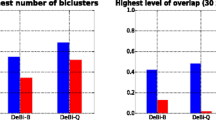Abstract
Microarray techniques have motivated the develop of different methods to extract useful information from a biological point of view. Biclustering algorithms obtain a set of genes with the same behaviour over a group of experimental conditions from gene expression data. In order to evaluate the quality of a bicluster, it is useful to identify specific tendencies represented by patterns on data. These patterns describe the behaviour of a bicluster obtained previously by an adequate biclustering technique from gene expression data. In this paper a new measure for evaluating biclusters is proposed. This measure captures a special kind of patterns with scaling trends which represents quality patterns. They are not contemplated with the previous evaluating measure accepted in the literature. This work is a first step to investigate methods that search biclusters based on the concept of shift and scale invariance. Experimental results based on the yeast cell cycle and the human B-cell lymphoma datasets are reported. Finally, the performance of the proposed technique is compared with an optimization method based on the Nelder-Mead Simplex search algorithm.
Preview
Unable to display preview. Download preview PDF.
Similar content being viewed by others
References
Ben-Dor, A., Shamir, R., Yakhini, Z.: Clustering Gene Expression Patterns. Journal of Computational Biology 6, 281–297 (1999)
Wang, H., Wang, W., Yang, J., Yu, P.S.: Clustering by Pattern Similarity in Large Data Sets. In: ACM SIGMOD International Conference on Management of Data, pp. 394–405 (2002)
Tanay, A., Sharan, R., Shamir, R.: Discovering Statistically Significant Biclusters in Gene Expression Data. Bioinformatics 18, 196–205 (2002)
Madeira, S.C., Oliveira, A.L.: Biclustering algorithms for biological data analysis: a survey. IEEE/ACM Transactions on Computational Biology and Bioinformatics 1, 24–45 (2004)
Divina, F., Aguilar-Ruiz, J.S.: Biclustering of Expression Data with Evolutionary Computation. IEEE Transactions on Knowledge & Data Engineering 18(5), 590–602 (2006)
Bryan, K., Cunningham, P., Bolshakova, N.: Biclustering of Expression Data Using Simulated Annealing. In: IEEE Symposium on Computer-Based Medical Systems, pp. 383–388 (2005)
Mitra, S., Banka, H.: Multi-objective evolutionary biclustering of gene expression data. Pattern Recognition 39(12), 2464–2477 (2006)
Cheng, Y., Church, G.M.: Biclustering of Expression Data. In: Proceedings of the 8th International Conference on Itelligent. Systems for Molecular Biology, La Jolla, CA, pp. 93–103 (2000)
Aguilar-Ruiz, J.S.: Shifting and Scaling Patterns from Gene Expression Data. Bioinformatics 21(20), 3840–3845 (2005)
Nelder, J.A., Mead, R.: A Simplex Method for Function Minimization. Computer J. 7, 308–313 (1965)
Bazaraa, M.S., Sherali, H.D., Shetty, C.M.: Nonlinear Programing: Theory and Algorithms. John Wiley and sons, Chichester (1993)
Fletcher, R.: A New Approach to Variable Metric Algorithms. Computer Journal 13, 317–322 (1970)
Shanno, D.F.: Conditioning of Quasi-Newton Methods for Function Minimization. Mathematics of Computing 24, 647–656 (1970)
Cho, R., et al.: A Genome-Wide Transcriptional Analysis of the Mitotic Cell Cycle. Molecular Cell 2, 65–73 (1998)
Alizadeh, A.A., et al.: Distinct Types of Diffuse Large b-cell Lymphoma Identified by Gene Expression Profiling. Nature 403, 503–511 (2000)
Author information
Authors and Affiliations
Editor information
Rights and permissions
Copyright information
© 2007 Springer-Verlag Berlin Heidelberg
About this paper
Cite this paper
Nepomuceno, J.A., Troncoso Lora, A., Aguilar–Ruiz, J.S., García–Gutiérrez, J. (2007). Biclusters Evaluation Based on Shifting and Scaling Patterns. In: Yin, H., Tino, P., Corchado, E., Byrne, W., Yao, X. (eds) Intelligent Data Engineering and Automated Learning - IDEAL 2007. IDEAL 2007. Lecture Notes in Computer Science, vol 4881. Springer, Berlin, Heidelberg. https://doi.org/10.1007/978-3-540-77226-2_84
Download citation
DOI: https://doi.org/10.1007/978-3-540-77226-2_84
Publisher Name: Springer, Berlin, Heidelberg
Print ISBN: 978-3-540-77225-5
Online ISBN: 978-3-540-77226-2
eBook Packages: Computer ScienceComputer Science (R0)




